Rail Baltica is the largest infrastructure project the Baltics have ever seen. It's a new railway that will connect the Baltics to the rest of the European rail network. Throughout the Estonian section of Rail Baltica, contractors use Dipperfox 850 stump crushers to handle this critical early phase across multiple work fronts.
Project Scope and Ground Conditions
In Estonia, Rail Baltica’s mainline runs roughly 220 kilometres from the capital, Tallinn, to Ikla on the Latvian border, cutting through forests, peatlands, fields, and existing road corridors.
Before a single track can be laid, thousands of tree stumps have to be removed to prepare a stable formation for the future railway.
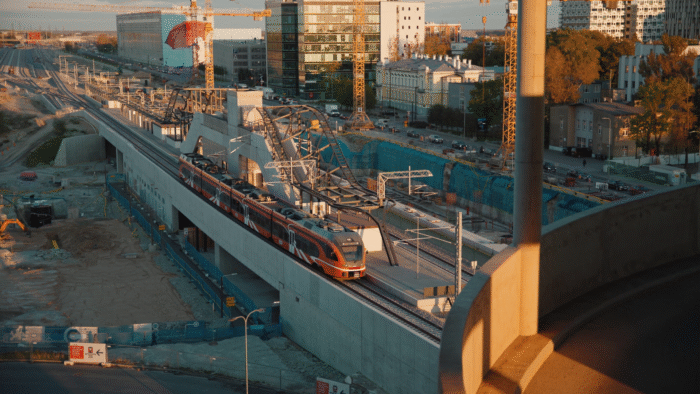
Rail Baltica's Ülemiste terminal in Tallinn, Estonia
The project’s fifth construction section in the Järvakandi area is a textbook example of large-scale stump removal. Here, TREV-2 Grupp is building approximately 14 kilometres of railway embankment, along with the station area and associated structures.
On this stretch, TREV-2 is responsible for clearing around 100 hectares of forest corridor so that the new station, embankments, and related infrastructure can be built without delay. That means dealing with thousands of stumps of varying sizes in a tight timeframe, with work progressing along long linear sections rather than compact, easy-to-access plots.
The contractor needs a method that removes stumps to the required depth while keeping the surface as stable and undisturbed as possible, so follow-up work such as topsoil stripping, embankment construction, and drainage can begin quickly.
In this context, Dipperfox 850 units are used as the primary stump removal solution across large sections of the project.
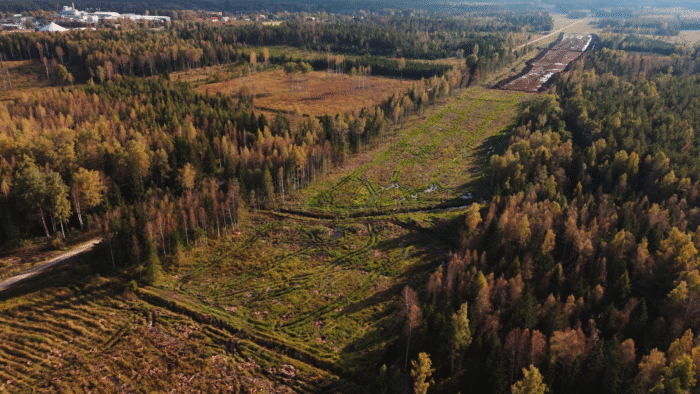
Rail Baltica's fifth mainline construction section in Järvakandi, Estonia
The Stump Removal Challenge on Large Infrastructure Projects
On a 220-kilometre railway job, “removing stumps” is anything but a small task.
Traditionally, on similar infrastructure projects, stumps are removed with excavators, ripped out of the ground, followed by heavy backfilling and compaction. These methods work for small plots or individual sites but become slow and expensive when scaled to tens or hundreds of hectares.
The old workflow at TREV-2 shows how complex this can get in practice. Stumps would be dug out, transported a few kilometres to an intermediate storage site, left to dry for months, shaken and cleaned, then left again before finally being chipped.
Even after all that, stump chips contaminated with sand are difficult to sell, because sand can melt into glass inside boiler houses and damage equipment.
Ripping stumps out leaves large holes that must be filled and compacted to strict railway standards, which means more material, more machine hours, and more passes with compaction equipment.

The stump removal process before switching to Dipperfox.
It also creates a logistics headache: piles of stumps that need to be loaded, hauled out of the corridor, and disposed of elsewhere. In Estonia, disposal also includes both transport and landfill fees; the latter can cost around 40€/ton of stump material (as of 2025). Every load of stumps you haul off-site is money straight out of the project budget.
The challenge for TREV-2 and other Rail Baltica contractors was to find a way to clear thousands of stumps faster, with less rework in the formation layer. This is the gap Dipperfox was brought in to fill.
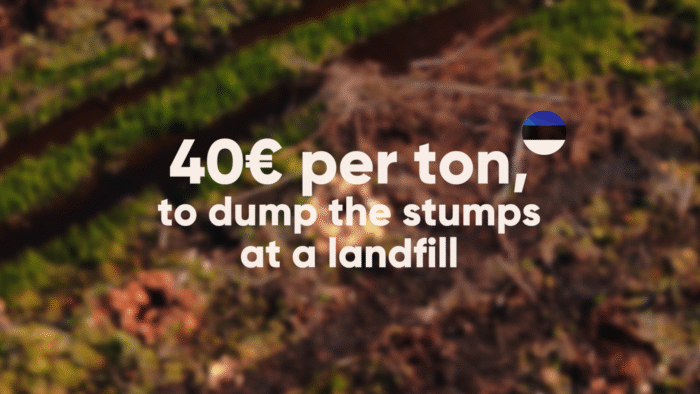
It costs 40€ to dump a ton of stump material at a landfill (as of 2025).
Why TREV-2 Chose Dipperfox SC850 Pro
For TREV-2 Grupp, the Rail Baltica sites combined three pressures: large areas, tight deadlines, and strict environmental requirements. A conventional “rip and haul” approach would have meant weeks of extra excavator work, constant truck movements to landfills, and more re-compaction on the future rail formation than the schedule could tolerate.
They needed a stump removal method that could keep pace with the rest of the rail earthworks.
Dipperfox 850 was initially developed for projects where stumps have to be removed on the scale of tens or even hundreds of hectares – precisely the situation on Rail Baltica.
It is particularly well-suited to creating road and rail corridors through clear-cut areas where stump diameters are close to “old-growth forest” size.

Clearing stumps to prepare the land for construction
In trials and early work phases, TREV-2 saw that one Dipperfox-equipped excavator could clear up to two hectares per day, helping them cut the previous overall destumping time from roughly 70 days to about 50 on comparable scopes of work.
Another decisive factor was logistics and sustainability. With Dipperfox, most of the material stays on site as mulch, so there is no need to load and transport bulky stumps to a landfill. The 850 model also fits the excavators already in TREV-2’s fleet, so the contractor could integrate the tool into existing workflows without buying special carriers.
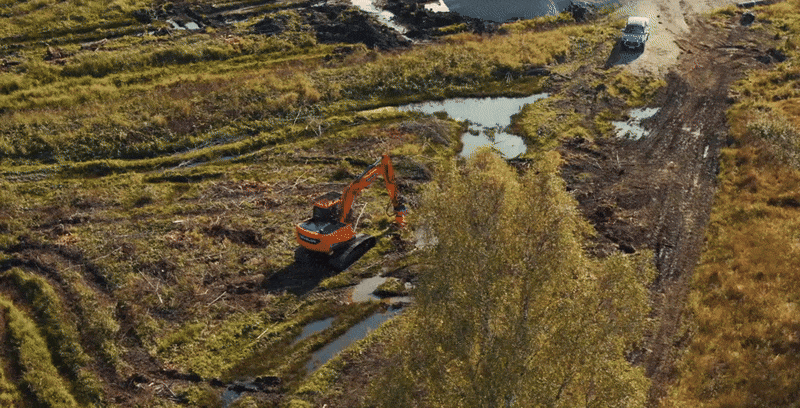
Work that was done in 70 days is now done in 50 days
Time, Cost, and Environmental Benefits
Cutting the destumping phase from about 70 days to 50 lets TREV-2 start embankment, drainage, and structures earlier, keeping the project ahead of key milestones.
The gain comes from faster stump removal, fewer machine changes, and far less rework on the formation layer. Once stumps are ground, holes are effectively pre-filled with chips, reducing the need for imported fill, heavy compaction, and the excavator and diesel hours that go with them.
Recycling stumps on site means fewer truckloads to the landfill and less double-handling of material, cutting fuel use and emissions. Because the surface isn’t torn up or littered with uprooted stumps, crews don’t need a second cleaning pass and can move straight on to stripping topsoil and building the embankment.
Operator and Contractor Feedback
For the people managing the project and operating the machinery, the difference is very tangible. Karl Kohler from TREV-2 Group sums it up simply:
“We chose Dipperfox because it’s faster, reduces pressure on the soil and the environment. Dipperfox saves us a lot of time. We can recycle the stumps on site.”
Machine operator Tõnu Kasvand from contractor Aru Tehnika, who has been an excavator operator for 14 years, says Dipperfox is the most effective stump removal tool on the market. In his experience, the Dipperfox stump drill is much gentler on the machine itself: it doesn’t “twist and abuse” the bucket and excavator as much. Less mechanical shock means less wear on the equipment over time.
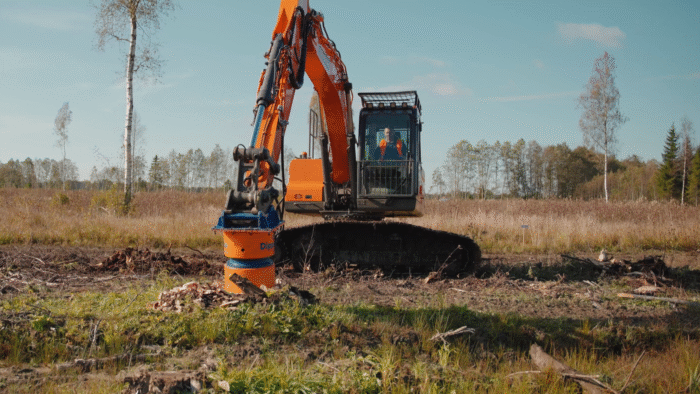
Veteran machine operator Tõnu Kasvand says that Dipperfox is the most effective stump removal tool on the market
Operators also appreciate that the Dipperfox 850 Pro’s automatic gearbox does much of the work in matching torque and speed to each stump. Grinding each stump in a matter of seconds rather than minutes keeps the workday flowing and reduces fatigue.
From a safety perspective, Tõnu also highlights that the Dipperfox stump drill doesn’t throw dangerous chips or fragments. The tool operates quietly and without aggressive flying debris, making the work zone calmer and safer.
For him, a nice bonus of the minor noise has been that wildlife, such as lynxes, wolves, and even bears, can regularly be seen nearby, and they don’t run away from the stump drill doing work.
Day-to-day maintenance is straightforward as well. Routine tasks such as changing or sharpening blades and replacing oils can be done directly in the forest, without having to move the machine back to a workshop. That keeps uptime high and prevents production interruptions.
Lessons for Other Large-Scale Infrastructure Projects
Rail Baltica shows that stump removal doesn’t have to be the slow, messy phase everyone dreads on large rail, road, pipeline, or utility projects.
Tools like the Dipperfox 850 really pay off when the work area spans tens or hundreds of hectares, when destumping is integrated into the normal earthworks flow, and when stumps are ground to protect the formation rather than ripped and backfilled.
TREV-2 now uses Dipperfox not only on Rail Baltica but also on projects such as widening the Tallinn–Tartu highway corridor and smaller infrastructure sites, and plans to use it on future Via Baltica highway sections. This shows how early choices about corridor clearing can shape schedule, cost, and long-term performance.
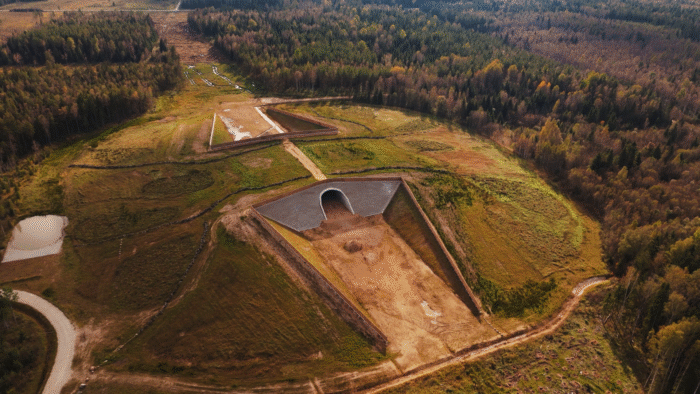
Ongoing works of the Rail Baltica project
If you’re planning a major project and need to remove many stumps, contact Dipperfox.
- area and stump density,
- typical stump sizes,
- soil conditions and constraints,
- machinery you already own and operate with.
We’ll recommend the right model, carrier setup, and working method for your site.
Whether you’re building a 200-kilometre railway, a bypass road, or converting plantations back to farmland, the Dipperfox team and dealer network can walk you through real numbers from Rail Baltica and similar jobs and help you choose the most efficient way to clear the ground for whatever you’re building next.




 Share
Share